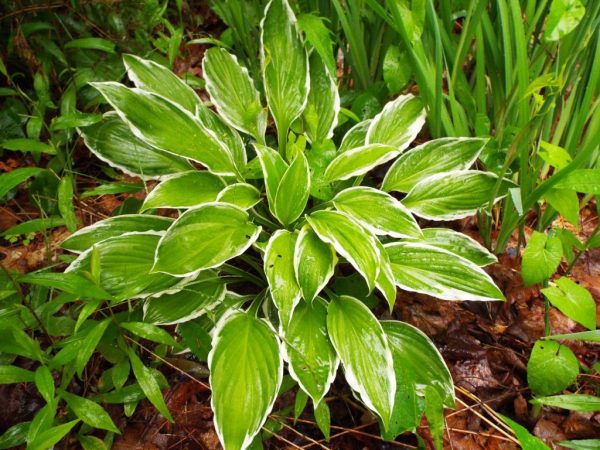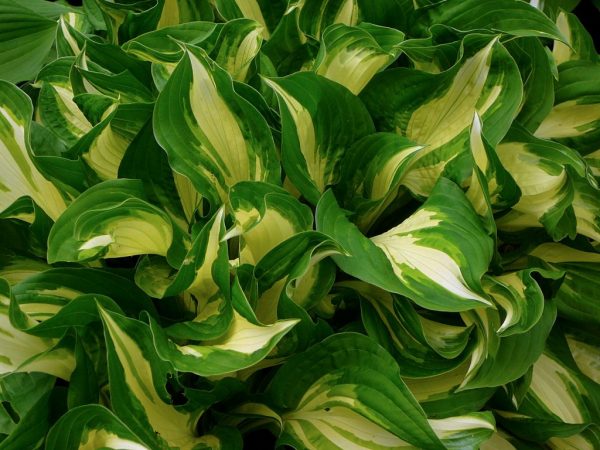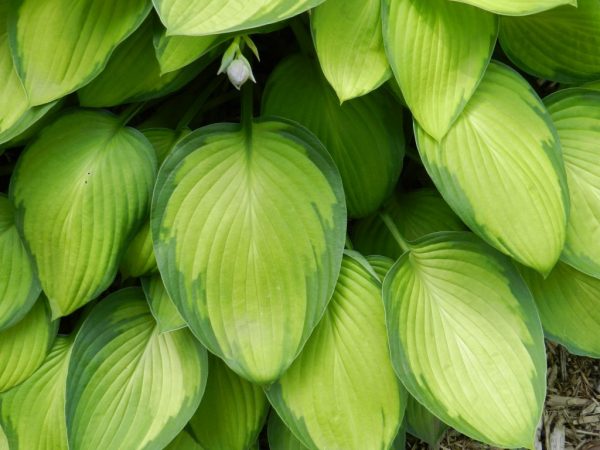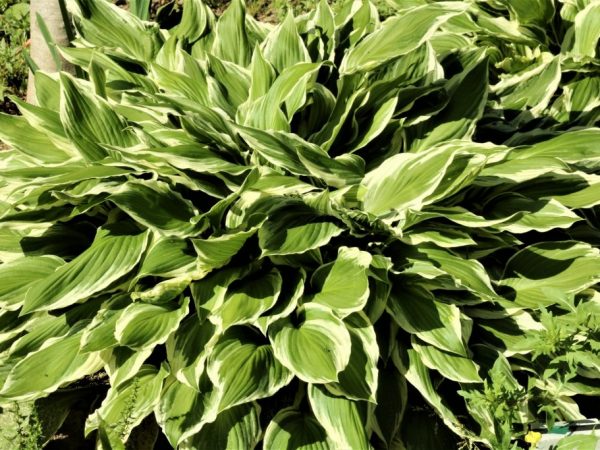Hosta Guacamole - care instructions
One of the finest plants for a shady garden is the ornamental perennial hosta Guacamole. It is a Fragrant Bouquet sport and was named Host of the Year by the American Breeders Association in 2002. Consider what a perennial looks like and what growing conditions are needed.

Hosta Guacamole
Description of the variety
The Latin name of the variety is hosta hybride guacamole.
The ornamental perennial Guacamole is a hemispherical, compact shrub (height - 60-65 cm).
It blooms with snow-white white flowers that bloom on the tops of flower arrows.
The length of the peduncles is 80-90 cm. The leaves are convex with a glossy surface, slightly corrugated, bright green in the center and with a wide emerald border along the edge. The size of the sheet plate is 25x21 cm;
Landing features
Timing
They are planted in spring when the temperature reaches 8-12 ° C and the soil warms up well. The best time is mid to late April.
Autumn landing is allowed in the south, but no later than the second half of September. So the seedlings will have time to take root and their roots will not freeze in winter.
The choice of planting material
You can buy planting material of this variety in a gardening nursery. Choose plants with unopened buds and closed root systems - in an earthen coma or container. Such specimens easily take root after landing on the site.
Place and soil
Hosta Guacamole fully grows and develops in a shaded area. But there is one regularity - the lighter the foliage of the plant, the more light it needs.
You can plant this perennial on a site where there is good lighting in the morning and evening, and partial shade at lunchtime. The soil should be moist, light and well-drained with a slightly acidic reaction.
Landing technique
The holes are made wide - about 50 cm, up to 30 cm deep.The optimal distance between them for group planting is 50-70 cm.

Hosta guacamole photo
Each hole is filled by 2/3 of the volume with a fertile mixture - the dug soil, peat and compost are mixed in equal amounts. The seedling is lowered into a hole, the roots are straightened, and covered with earth so that no voids are formed. Then watered, mulched with wood chips or peat.
When planting, it is important that the bud is flush with the ground.
Care requirements
Watering
In the first 3 weeks, watered every three days so that the roots take root faster. Further moistening is necessary as the soil dries to a depth of 4-5 cm.
Use warm and settled water. Pour at the very root, water should not fall on the foliage.
After the procedure, the soil is carefully loosened, the flower bed is cleaned of weeds, and mulch from peat or sawdust is added to the tree trunk circle.
Top dressing
Hosta has high decorative qualities, which is regularly fed. Fertilization begins in the second year of life 3 times per season - in early spring, at the stage of budding and after flowering.
For this purpose, ready-made complexes are used, which include nitrogen, phosphorus and potassium. Dosage according to the instructions on the package.
In the fall, compost or last year's manure is embedded in the soil around the bushes.
Food is combined with watering, which helps the roots to absorb nutrients faster.
Pruning
This plant does not need shaping, because it initially develops a compact and neat hemispherical crown. Throughout the growing season, yellowed, decayed and damaged by diseases, parasites, foliage are cut out.
Additionally, in the fall, cut off the peduncles that have faded.
Preparing for winter
Hybrid Hosta Guacamole is a frost-resistant crop, but in a fierce winter with severe frosts, the root system can freeze.

Hosta guacamole photo description
After the end of the growing season, all the leaves are cut out, the trunk circle is sprinkled with a thick layer of peat or fallen leaves, spruce branches are laid on top.
They remove the shelter in the spring, when the snow thaws and the last frosts pass.
Reproduction
There are two successful options for breeding new seedlings, each with pros and cons:
- By dividing the rhizome. At the end of May or at the beginning of summer, the bush is watered, removed, dipped in a container of water to wash off the remnants of the earth. It is dried, divided into parts with a garden shovel, so that the seedling has one bud and several roots. The slices are sprinkled with charcoal. They are seated separately in the garden.
- Cuttings. The essence of the method is to separate the stalk with a root or heel from the mother bush. Then it is dipped in Kornevin's solution for half an hour, planted in a mixture of peat and sand. Over the course of a month, they are periodically watered, and after this time, when the shoot begins to grow, they are transplanted to the site.
Seed cultivation is rarely practiced because seeds have poor germination and require special conditions for germination.
Diseases and pests
This perennial culture rarely gets sick, weakened bushes that have not been given basic care or planting rules are violated more often.

Hosta hosta guacamole
The most common disease is phyllosticosis. The leaves are covered with yellow-brown shapeless spots. It is not subject to treatment, so the bush is dug up, burned. The place of its growth is spilled with a solution of copper sulfate.
Of the pests, slugs are annoying. They eat away tissues, leaving silvery stripes on the surface of the foliage. To scare away, they use different methods - they mulch the near-trunk zone with prickly material - rubble, broken shells.
To combat grasshoppers and caterpillars, special insecticides are used.
Application in garden design
This variety is very popular in modern design - a versatile bush goes well with different vegetation - stunted conifers, geraniums, horned goat weed, primrose. Looks beautiful on a flower bed with astilba, anemone, lungwort, foxglove.
Hosta looks spectacular surrounded by ground cover crops - mosses, heather, creeping junipers.
It is often used to frame paths and decorate alleys. They are planted along curbs and fences, making a small indent.
A perennial bush is considered an excellent option for landscaping vertical flower beds, mixborders, rabatoks and rockeries.
It is not recommended to plant together with roses, since both plants have different light requirements.
Testimonials
Hosta hybride guacamole has received many positive reviews from gardeners, thanks to which it is cultivated in many regions of our country:
- does not need the formation of a crown, does not take up much space, tolerates light shading well, therefore it grows safely in tiny areas;
- many manage to successfully propagate the bush and grow new seedlings with all the varietal characteristics of the mother plant;
- blends with any vegetation in the garden and is suitable for the most unusual compositions.


